El Cuerpo de Ejército del Noroeste
Following Obregón's original issues in Culiacán, Sinaloa, he made a similar issue in Tepic. Obregón arrived in Tepic on 19 May 1914, shortly after its capture by Generals Lucio Blanco and Manuel M. Dieguez. Perhaps because he could not obtain what he wanted through a forced loan, to provides the funds he needed, with Carranza’s authorisation, he had his Cuartel General make this new issue of $60,000En Tepic volvieron a agotarse los fondos para las atenciones de las fuerzas, y como éstas estaban próximas a internarse en una zona donde no había medios eficaces de comunicación para hacernos llegar los fondos necesarios, el Cuartel General de mi cargo, con previa autorización de la Primera Jefatura, hizo una nueva emisión de vales provisionales por valor de $60,000.00 (Report from Obregón, Casa Blanca, Sinaloa, to Carranza, 16 May 1914 in Alvaron Obregón, Ocho mil kilómetros en campaña, p.125). Salvador Gutiérrez Contreras. Movimientos revolucionarios en Nayarit, Universidad Autónoma de Nayarit, Tepic 2013, pp 96s.
These were Series B, of notes of 50c, $1, $5[image needed], $10, $20[image needed] and $50[image needed] dated 10 June 1914 with the printed signature of Alvaro Obregón as General en Jefe and the facsimile stamp of F. R. Serrano as Mayor Jefe de Estado Mayor.
|
Forced to choose at the Convention of Aguascalientes, Obregón naturally sided with Carranza. He easily defeated the Zapatista forces at Puebla in early 1915, and then beat Villa in four battles, collectively known as the Battle of Celaya, in April to July 1915. In 1920, frustrated in his political ambitions, Obregón launched a revolt against Carranza, in which Carranza was assassinated. Obregón won the subsequent presidential election with overwhelming support and brought a measure of stability to the country in his four year term. In 1924, Obregón's fellow Northern revolutionary general and hand-picked successor, Plutarco Elías Calles, was elected president. Although Obregón ostensibly retired to Sonora, he remained influential under Calles. Having pushed through constitutional reform to again make reelection possible, Obregón won the 1928 election, but he was assassinated before beginning his second term, by José de León Toral, a Mexican offended by the government's anti-religious laws. |
|
|
In 1927 he was a candidate for the presidency against Obregón, who was seeking a second term. Serrano was arrested for plotting against Obregón, and on 3 October, along with several other prisoners, was murdered on Obregón’s orders. |
 |
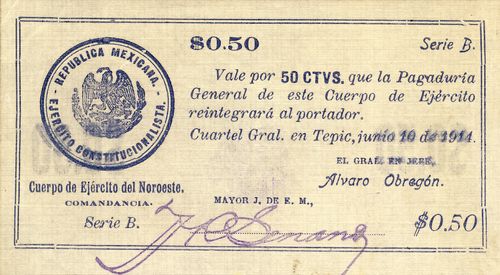

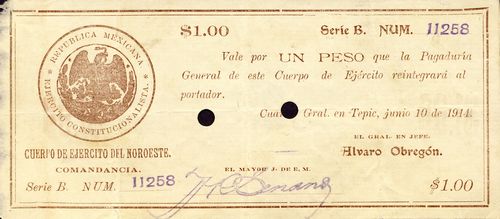
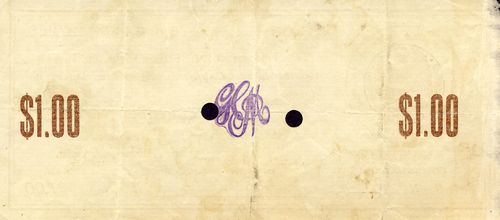


| series | from | to | total number |
total value |
||
| 50c | B | includes number 20395 (probably counterfeit) | ||||
| unnumbered | ||||||
| $1 | B | includes numbers 5484CNBanxico #5437 to 11281 | ||||
| $5 | B | |||||
| $10 | B | includes number 26917 | ||||
| $20 | B | |||||
| $50 | B | |||||
| $60,000 |
This provisional currency was used to purchase supplies, and as there was no railroad track between Tepic and San Marcos, JaIisco, carts and mules also had to be acquired in order to transport the provisions and equipment across the mountains Alvaro Obregón, Ocho mil kilómetros en campaña, 1917 pp. 124-25
Counterfeits
Counterfeit 50c notes quickly appeared, and was the reason why these notes were withdrawn. “As some quantities of counterfeit banknotes have been collected from those put into circulation by the General Headquarters in the Territory of Tepic, the Constitutionalist Government has agreed to collect those same banknotes, prohibiting their circulation” Boletín Militar, Tomo I, Núm. 33 22 August 1914.
One possibility is
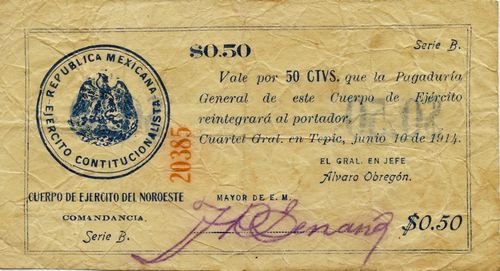
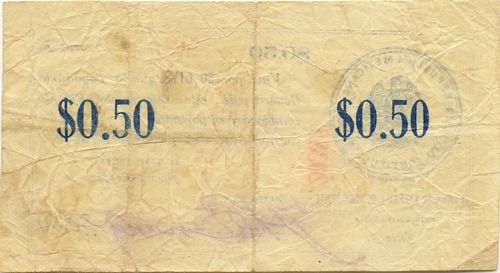
The differences include
| GENUINE | COUNTERFEIT |
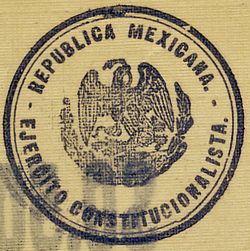
Eagle faces right. Seal has break at 1.00. Border edges have breaks |
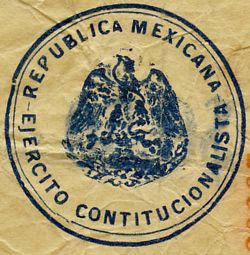
Eagle faces left. No break in seal |

|

different font and spacing |

|
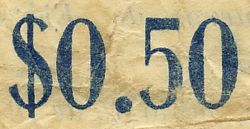
different font for value |
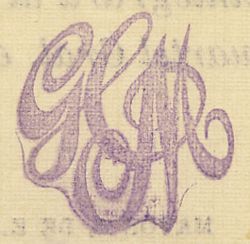
|
no monogram on reverse |
Withdrawal
On 16 August 1914 the Secretaría de Guerra told General Manuel M. Diéguez to withdraw the notes Boletín Militar, Tomo I, Núm. 33, 22 August 1914. So, on 21 August 1914 the Comandancia Militar in Guadalajara announced that the notes had been suspended and would be exchanged within ten daysEl Reformador, Tomo I, Núm. 18, 21 August 1914: Boletín Militar, Tomo I, Núm. 33, 22 August 1914. Obregón sent an agent from Mexico City with sufficient funds México Libre, Núm. 11, 22 August 1914. Up until 10 September the notes were exchanged in the oficinas rentisticas, and thereafter in the Dirección General de RentasMéxico Libre, 24, 4 September 1914: México Libre, Año I, Tomo I, Núm. 31, 11 September 1914.
On 28 April 1916 as part of the unification of the currency Carranza listed various issues that the Tesorería General de la Nación, the Jefaturas de Hacienda and the Administraciones Principales del Timbre would receive on deposit, to be redeemed at a later date, including "vales del Cuerpo de Ejército del Noroeste, emitidos en Tepic el 10 de junio de 1914, y firmados por Alvaro Obregón y F. R. Serrano" and "vales del Cuerpo de Ejército del Noroeste, emitidos en Tepic el 10 de julio de 1914, y firmados por Alvaro Obregón y F. R. Serrano". Finally in September 1917 when Carranza strictly prohibited any transaction with "vales del Cuerpo de Ejército del Noroeste, emitidos en Tepic el 10 de junio de 1914, y firmados por Alvaro Obregón y F. R. Serrano" and "vales del Cuerpo de Ejército del Noroeste, emitidos en Tepic el 10 de julio de 1914, y firmados por Alvaro Obregón y F. R. Serrano".

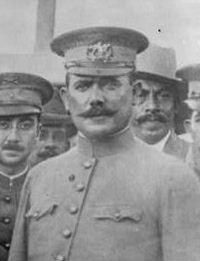 Alvaro Obregón was born in Siquisiva, Sonora in 1880. He entered politics in 1911 with his election as municipal president of the town of Huatabampo, Sonora and became a supporter of Madero shortly after Madero became President of Mexico. In April 1912 he volunteered to join the local Maderista forces to oppose Pascual Orozco’s revolt and was quickly promoted through the ranks. On Madero’s assassination he offered his services to the government of Sonora in opposition to the Huerta regime. On 30 September 1913 Carranza appointed Obregón commander-in-chief of the Constitutional Army in the Northwest, with jurisdiction over Sonora, Sinaloa, Durango, Chihuahua, and Baja California.
Alvaro Obregón was born in Siquisiva, Sonora in 1880. He entered politics in 1911 with his election as municipal president of the town of Huatabampo, Sonora and became a supporter of Madero shortly after Madero became President of Mexico. In April 1912 he volunteered to join the local Maderista forces to oppose Pascual Orozco’s revolt and was quickly promoted through the ranks. On Madero’s assassination he offered his services to the government of Sonora in opposition to the Huerta regime. On 30 September 1913 Carranza appointed Obregón commander-in-chief of the Constitutional Army in the Northwest, with jurisdiction over Sonora, Sinaloa, Durango, Chihuahua, and Baja California.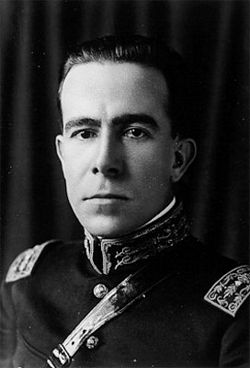 Francisco Roque Serrano Barbeytia was born on 16 August 1889 in Santa Ana, Sinaloa. He was working as an accountant in Sonora when in 1910 he joined the revolutionary movement, and after Maderos’assasination, served in Obregón’s Cuerpo de Ejército del Noroeste. He rose to be a General de Brigada and fought throughout Mexico against federal forces, Villistas and Zapatistas, and then Yaquis and supporters of de la Huerta’s rebellion.
Francisco Roque Serrano Barbeytia was born on 16 August 1889 in Santa Ana, Sinaloa. He was working as an accountant in Sonora when in 1910 he joined the revolutionary movement, and after Maderos’assasination, served in Obregón’s Cuerpo de Ejército del Noroeste. He rose to be a General de Brigada and fought throughout Mexico against federal forces, Villistas and Zapatistas, and then Yaquis and supporters of de la Huerta’s rebellion.